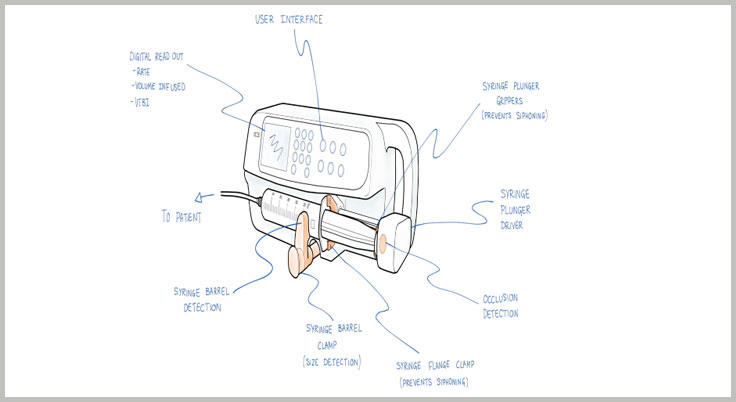
SYRINGE INFUSION PUMP
A syringe pump is a specialized medical device designed to inject Medications into a system with an impressive level of precision & control. These pumps operate by pushing a plunger within a syringe, enabling consistent, pulseless & controlled flow of the syringe’s content. They play a vital role in critical care settings, where precise dosing is paramount in ensuring accurate delivery of drugs over a specified period. These pumps are commonly used for dissolving and injecting medicines, providing bolus doses in emergency situations, and maintaining continuous infusion for patients requiring long-term treatment.
Syringe pumps are essential in various hospital departments, including Pediatric Intensive Care Units (PICU), Special Newborn Care Units (SNCU), Intensive Care Units (ICU), Cardiac Care Units, and High Dependency Units (HDU). Additionally, they can also be used in Operating Theaters (OT), General Medicine Wards, Emergency Wards, and Dialysis Units, as per the need. Patients who are ventilator-dependent, suffering from respiratory distress, undergoing cancer treatment, or experiencing cardiac complications often require 24/7 medication support via syringe pumps.
On an average, it takes around five minutes to connect a syringe pump to a patient, with the doctor determining the exact infusion volume required. Given the critical nature of these devices, hospitals must prioritize quality, ease of use, and serviceability when selecting syringe pumps for their facilities.
The user interface and operating modes of the syringe pumps should be easy to understand to minimize human errors during delivery of precise dosage. Poor syringe quality or mechanical malfunctions can lead to occlusion, affecting the delivery of medication. Codex Syringe Pump offers a special feature of Alarm in case of Occlusion.
Another key feature of Codex syringe pump is the bolus button, which allows for the rapid infusion of life-saving medications when needed. Additionally, battery-operated models provide reliability during power failures and prevent potential malfunctions caused by voltage fluctuations. The battery of Codex Syringe Pump may last from 4-8 Hrs depending on model in use.
General Recommendations:
1. Hospital with 10 bedded PICU/SNCU Unit
In pediatric critical care, particularly for newborns, a minimum of three syringe pumps per bed is required to simultaneously administer fluids, drugs, and antibiotics. Therefore, a minimum of 30 syringe pumps are required to ensure continuous patient care without disruptions. The demand for these devices highlights their importance in maintaining precise and timely drug administration.
Despite their advantages, syringe pumps come with certain challenges. Since, they are precise, for any error in setting the flow rate and the volume might lead patients to encounter adverse effects.

2. Purchasing from the Same Manufacturer
As per the IPHS guidelines 2022, the Staff Nurse provides patient care, administers medications, assists in procedures, manages records, ensures safety and hygiene, supervises staff, and supports healthcare programs while maintaining confidentiality and compliance with medical protocols (Ref: Page no. 72 to 74; IPHS Guidelines). Managing all these responsibilities simultaneously can lead to medical errors, especially in disaster situations. Therefore, it is crucial to ensure that all syringe pumps in a hospital operate on the same system and interface, enhancing efficiency, reducing confusion among medical staff, and improving patient safety. This standardization also simplifies nurse training and enables in-house resolution of operational issues. To achieve this, hospitals should consider purchasing syringe pumps from a single manufacturer, ensuring uniform operation, streamlined training, and efficient maintenance, ultimately reducing medical errors.

3. Syringe Selection and Labeling for Accurate Drug Administration
For small dosages ranging from 0.1ml to 5 ml per hour, a 20 cc syringe should be used to ensure precision. For dosages of 10 ml per hour or more, a larger 50/60 cc syringe is recommended to maintain accuracy and convenience. Codex Syringe Pump automatically detects Syringe Volume and stacking of 3 to 4 machines. When multiple syringe pumps are used on a single patient. It is essential to clearly label each syringe with the name of the drug to prevent medication errors and ensure patient safety. The units of volume, such as microliters (µL) or milliliters (mL), and units of time, such as seconds (sec), minutes (min), or hours (hr), should be used correctly by the staff, and syringes should be selected accordingly.

